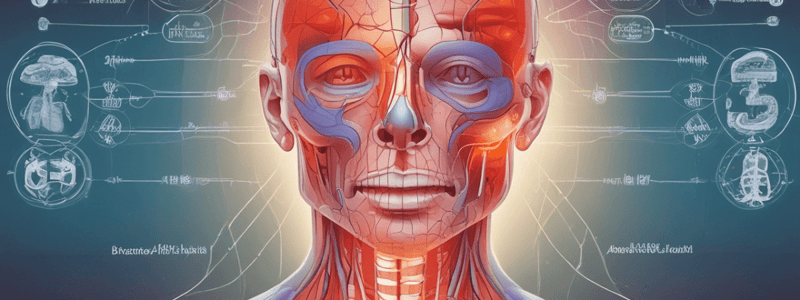Podcast
Questions and Answers
What are first line recommendations for patients experiencing MILD acute pain?
What are first line recommendations for patients experiencing MILD acute pain?
- Corticosteroids
- Acetaminophen, NSAIDS, and RICE (correct)
- Opioids
- Manipulations
What is the first line recommendation for patients experiencing MODERATE to SEVERE acute pain?
What is the first line recommendation for patients experiencing MODERATE to SEVERE acute pain?
- NSAIDS and RICE
- Corticosteroids
- Opioids (correct)
- Acetaminophen
In the management of chronic pain, opioids are indicates as a first line treatment.
In the management of chronic pain, opioids are indicates as a first line treatment.
False (B)
When it comes to Chronic pain management, continue therapy only if there is clinically meaningful improvement in pain and function.
When it comes to Chronic pain management, continue therapy only if there is clinically meaningful improvement in pain and function.
Nonopioid therapies are at LEAST as effective as opioids for many common types of acute pain.
Nonopioid therapies are at LEAST as effective as opioids for many common types of acute pain.
Before prescribing opioid therapy for acute pain, clinicians should discuss with patients the realistic benefits and known risks of opioid therapy.
Before prescribing opioid therapy for acute pain, clinicians should discuss with patients the realistic benefits and known risks of opioid therapy.
For acute pain management, use longer acting immediate release opioids if opioid are indicated for the patient.
For acute pain management, use longer acting immediate release opioids if opioid are indicated for the patient.
What are examples of rehabilitative non-pharmaceutical therapies that can be used for patients?
What are examples of rehabilitative non-pharmaceutical therapies that can be used for patients?
What are examples of psychological non-pharmaceutical therapies that can be used for patients?
What are examples of psychological non-pharmaceutical therapies that can be used for patients?
What are examples of interventional non-pharmaceutical therapies that can be used for patients?
What are examples of interventional non-pharmaceutical therapies that can be used for patients?
What are examples of Complementary and Alternative non-pharmaceutical therapies that can be used for patients?
What are examples of Complementary and Alternative non-pharmaceutical therapies that can be used for patients?
Sickle cell crisis or acute pancreatitis patients are candidates for short term opioid use.
Sickle cell crisis or acute pancreatitis patients are candidates for short term opioid use.
What receptor do opioids work on?
What receptor do opioids work on?
What is the GOLD standard opioid?
What is the GOLD standard opioid?
Morphine is a CNS depressant
Morphine is a CNS depressant
What patient should avoid oxycodone?
What patient should avoid oxycodone?
Hydromorphone is __x more potent than morphine. It is a good agent for digestive pain.
Hydromorphone is __x more potent than morphine. It is a good agent for digestive pain.
What opioid contains acetaminophen?
What opioid contains acetaminophen?
What opioid has an immediate onset but is VERY potent? It also functions as a Serotonergic (serotonin syndrome).
What opioid has an immediate onset but is VERY potent? It also functions as a Serotonergic (serotonin syndrome).
What opioid may be use to augment therapy, but is also serotonergic?
What opioid may be use to augment therapy, but is also serotonergic?
What more minor opioid can be prescribed and works additionally as a cough suppressant?
What more minor opioid can be prescribed and works additionally as a cough suppressant?
You should always prescribe NARCAN to any patients that are being prescribed an opioid.
You should always prescribe NARCAN to any patients that are being prescribed an opioid.
What tool should be administered to patients upon an initial visit prior to beginning opioid therapy for pain management?
What tool should be administered to patients upon an initial visit prior to beginning opioid therapy for pain management?
What opioid would you use for a patient with renal dysfunction, patients taking too many tablets, unbearable side effects of high dose opioids?
What opioid would you use for a patient with renal dysfunction, patients taking too many tablets, unbearable side effects of high dose opioids?
What opioid agent can be used for moderate to severe pain but has a ceiling effect that decreases the risk of CNS depression?
What opioid agent can be used for moderate to severe pain but has a ceiling effect that decreases the risk of CNS depression?
ALL opioids have the same MME (morphine mg equivalence)
ALL opioids have the same MME (morphine mg equivalence)
How do you calculate equianalgesic doses for opioids?
How do you calculate equianalgesic doses for opioids?
Avoid prescribing opioids and benzodiazepines concurrently
Avoid prescribing opioids and benzodiazepines concurrently
You should review patient’s history of controlled substance prescriptions using state prescription drug monitoring program (PMP) before starting a opioid
You should review patient’s history of controlled substance prescriptions using state prescription drug monitoring program (PMP) before starting a opioid
The lowest starting dose for opioid-naïve patients is
The lowest starting dose for opioid-naïve patients is
___ day for Acute/ 7-day surg, ___day for chronic pain, ____ day reviewed by DO/MD
___ day for Acute/ 7-day surg, ___day for chronic pain, ____ day reviewed by DO/MD
When patients have been taking opioids for longer durations (e.g., for ≥1 year), tapers of ____% per month or slower are likely to be better tolerated than more rapid tapers.
When patients have been taking opioids for longer durations (e.g., for ≥1 year), tapers of ____% per month or slower are likely to be better tolerated than more rapid tapers.
What is the max dose for acetaminophen?
What is the max dose for acetaminophen?
How are drugs classified?
How are drugs classified?
Ketamine is only indicated for in-patient treatment
Ketamine is only indicated for in-patient treatment
What types of drug can be used for purposes such as mild to moderate pain management, osteoarthritis, rheumatoid arthritis, gout, cardiovascular disease prevention, post-stent care, colorectal cancer risk reduction, migraine relief, pericarditis treatment, polycythemia vera prevention, preeclampsia management, valvular disease management, thromboembolism prevention, and arthroplasty prevention?
What types of drug can be used for purposes such as mild to moderate pain management, osteoarthritis, rheumatoid arthritis, gout, cardiovascular disease prevention, post-stent care, colorectal cancer risk reduction, migraine relief, pericarditis treatment, polycythemia vera prevention, preeclampsia management, valvular disease management, thromboembolism prevention, and arthroplasty prevention?
Which drug profiles may be suitable candidates for aspirin in managing moderate to severe acute pain, addressing conditions such as opioid pain, migraines, post-operative cataracts, corneal refractive surgeries, and seasonal allergic conjunctivitis?
Which drug profiles may be suitable candidates for aspirin in managing moderate to severe acute pain, addressing conditions such as opioid pain, migraines, post-operative cataracts, corneal refractive surgeries, and seasonal allergic conjunctivitis?
What pain medication should not be used for patients with sulfa allergies?
What pain medication should not be used for patients with sulfa allergies?
NSAIDS have an increased risk of CVA
NSAIDS have an increased risk of CVA
What drug can be used for managing diabetic neuropathy, post-herpetic neuralgia, chronic neuropathic pain, fibromyalgia, cough, restless leg syndrome, seizures, generalized anxiety disorder (GAD), social anxiety disorder (SAD), vasomotor symptoms of menopause, and pruritus?
What drug can be used for managing diabetic neuropathy, post-herpetic neuralgia, chronic neuropathic pain, fibromyalgia, cough, restless leg syndrome, seizures, generalized anxiety disorder (GAD), social anxiety disorder (SAD), vasomotor symptoms of menopause, and pruritus?
What medication addressing conditions like diabetic peripheral neuropathy, post-herpetic neuralgia, fibromyalgia, osteoarthritis, and chronic pain management?
What medication addressing conditions like diabetic peripheral neuropathy, post-herpetic neuralgia, fibromyalgia, osteoarthritis, and chronic pain management?
What can be used as adjunct therapy for acute musculoskeletal conditions?
What can be used as adjunct therapy for acute musculoskeletal conditions?
What can acetaminophen cause in the long-term?
What can acetaminophen cause in the long-term?
Study Notes
Acute Pain Management
- For mild acute pain, first-line recommendation is nonopioid therapy.
- For moderate to severe acute pain, first-line recommendation is not opioids.
- Nonopioid therapies are at least as effective as opioids for many common types of acute pain.
- Before prescribing opioid therapy, clinicians should discuss realistic benefits and known risks with patients.
- For acute pain management, use longer acting immediate release opioids if opioid is indicated.
Chronic Pain Management
- Opioids are not indicated as a first-line treatment for chronic pain.
- Continue therapy only if there is clinically meaningful improvement in pain and function.
Non-Pharmaceutical Therapies
- Examples of rehabilitative therapies:
- Examples of psychological therapies:
- Examples of interventional therapies:
- Examples of Complementary and Alternative therapies:
Opioids
- Opioids work on the mu receptor.
- Morphine is the gold standard opioid and a CNS depressant.
- Hydromorphone is 2-4 times more potent than morphine and is a good agent for digestive pain.
- Percocet contains acetaminophen.
- Fentanyl has an immediate onset but is very potent and also functions as a Serotonergic (serotonin syndrome).
- Methadone may be used to augment therapy but is also serotonergic.
- Codeine is a more minor opioid that can be prescribed and works additionally as a cough suppressant.
- NARCAN should always be prescribed to patients being prescribed an opioid.
- The tool that should be administered to patients upon an initial visit prior to beginning opioid therapy is the Opioid Risk Tool (ORT).
Safe Opioid Prescribing
- When patients have been taking opioids for longer durations (e.g., for ≥1 year), tapers of 10% per month or slower are likely to be better tolerated than more rapid tapers.
- Avoid prescribing opioids and benzodiazepines concurrently.
- Review patient’s history of controlled substance prescriptions using state prescription drug monitoring program (PMP) before starting a opioid.
- The lowest starting dose for opioid-naïve patients is 3-day for Acute/ 7-day surgical, 7-day for chronic pain, and 7-day reviewed by DO/MD.
Other Medications
- The maximum dose for acetaminophen is 3,000 mg/day.
- Drugs are classified by their mechanism of action.
- Ketamine is only indicated for in-patient treatment.
- NSAIDS have an increased risk of CVA and are suitable for purposes such as mild to moderate pain management, osteoarthritis, rheumatoid arthritis, and more.
- Aspirin is suitable for managing moderate to severe acute pain, addressing conditions such as opioid pain, migraines, and more.
- Sulfa allergic patients should not use sulfonamide-containing medications like celecoxib.
- Gabapentin can be used for managing diabetic neuropathy, post-herpetic neuralgia, chronic neuropathic pain, and more.
- Duloxetine can be used for addressing conditions like diabetic peripheral neuropathy, post-herpetic neuralgia, fibromyalgia, and osteoarthritis.
- Cyclobenzaprine can be used as adjunct therapy for acute musculoskeletal conditions.
- Long-term use of acetaminophen can cause liver damage.
Studying That Suits You
Use AI to generate personalized quizzes and flashcards to suit your learning preferences.
Description
This quiz covers the initial steps healthcare providers recommend for patients experiencing sudden onset of pain. Test your knowledge on the immediate actions to take for managing acute pain.




